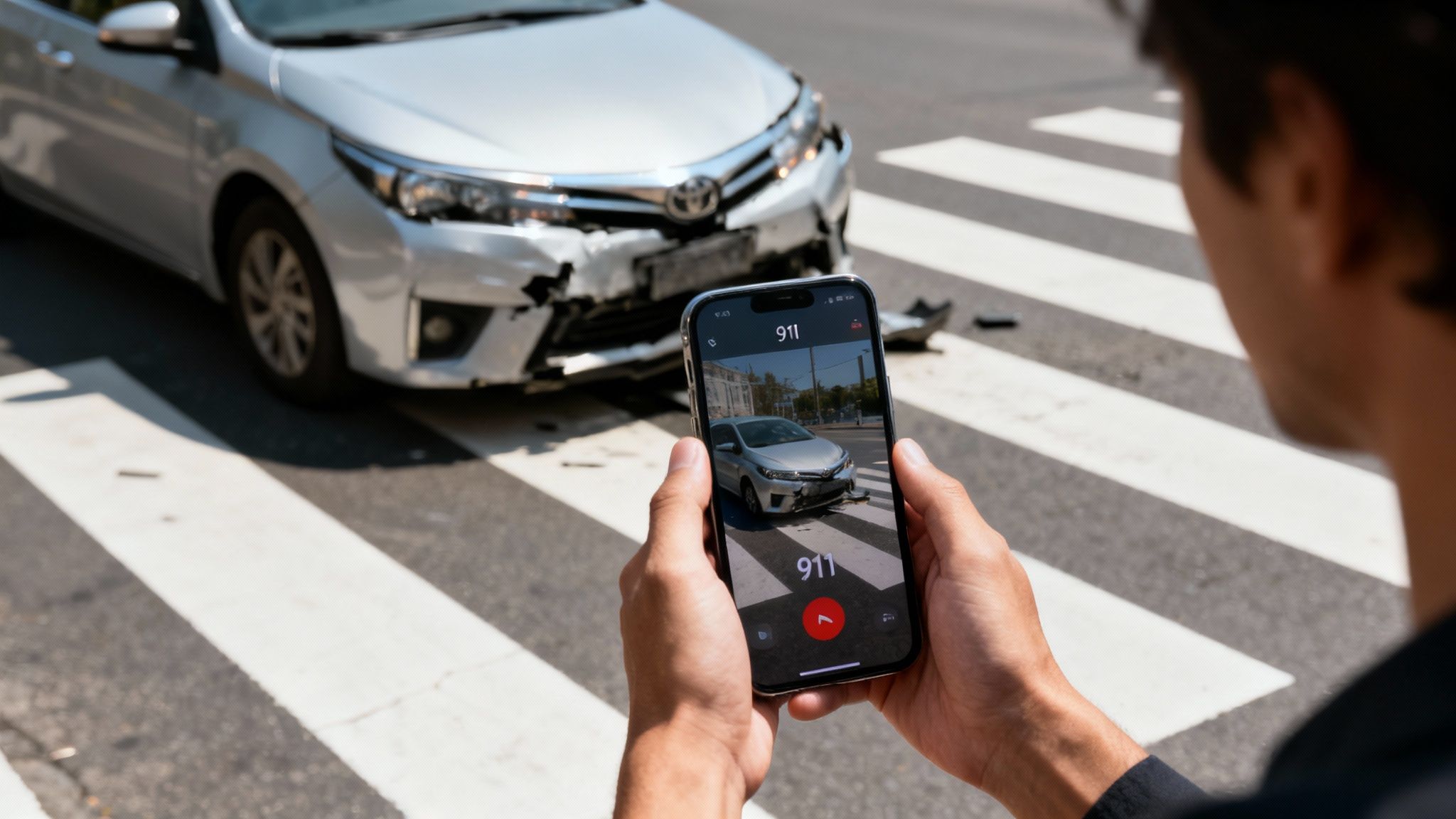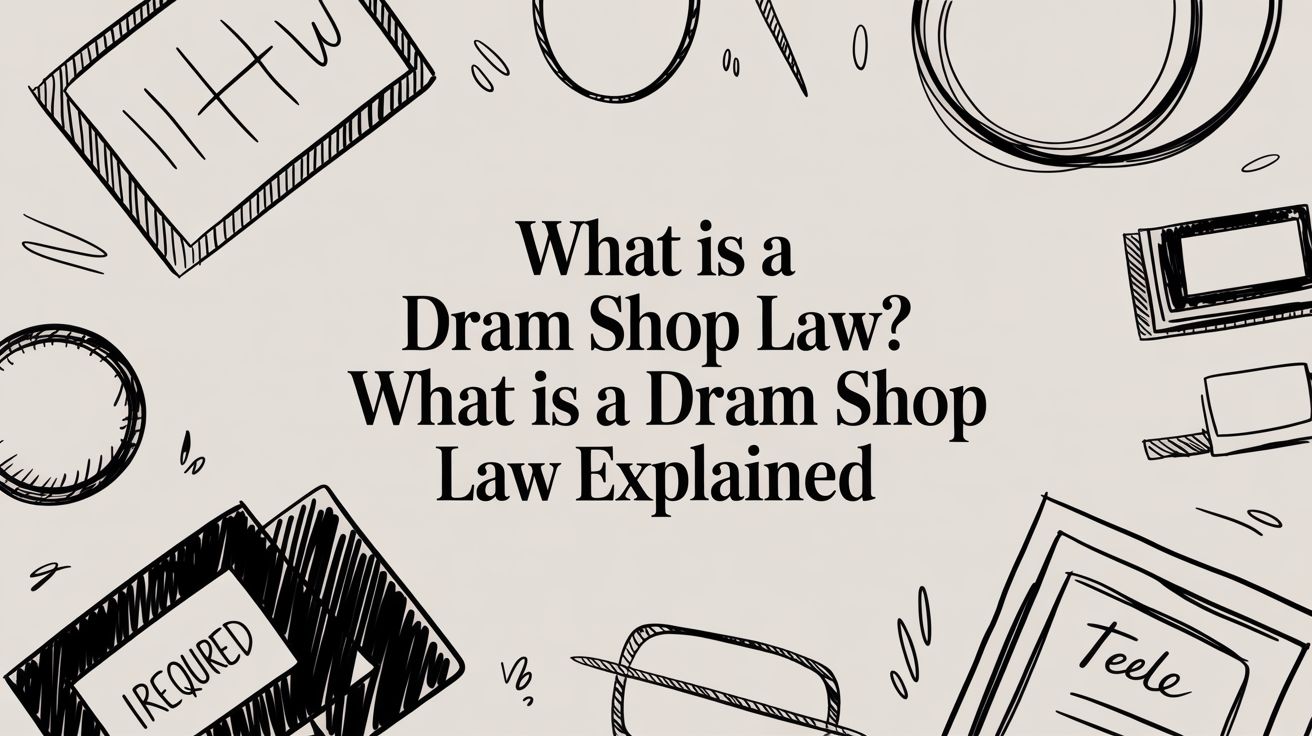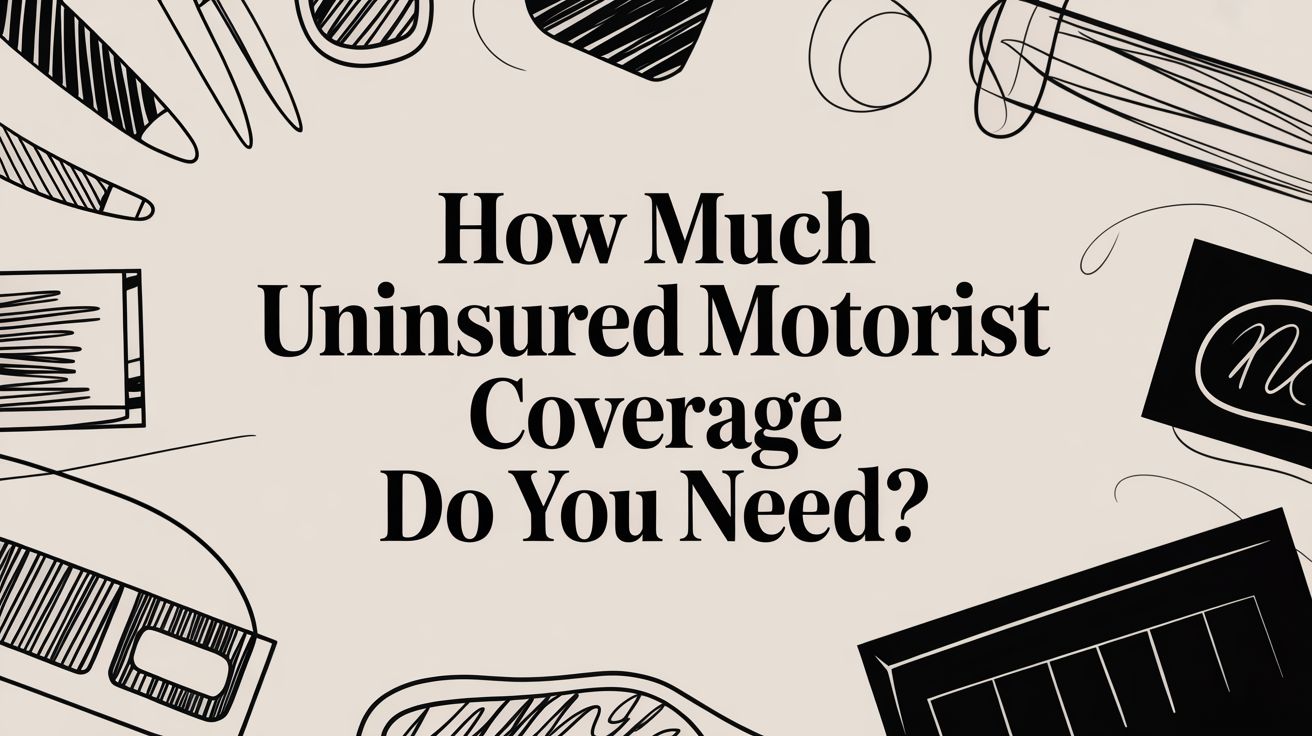A serious accident can change your life in seconds — but you don’t have to face it alone. If you've been hit by a car, the financial and personal toll can feel overwhelming. Fortunately, Texas law gives you a path to recover what you've lost. This is known as pedestrian hit by car compensation, and it’s designed to cover everything from your medical bills to the personal suffering you’ve endured.
How much you can recover isn't a simple number; it depends on the unique details of your accident, how severe your injuries are, and the strength of your case. An experienced Texas personal injury lawyer can help you understand the full value of your claim.
Your Rights After a Texas Pedestrian Accident
Being struck by a vehicle leaves more than just physical scars. You're dealing with emotional trauma and a mountain of financial stress. When a driver's negligence leaves you hurt, Texas law is on your side, providing a clear way to hold them accountable. Understanding what you're entitled to is the first step toward getting justice and putting your life back together.
In legal terms, all of these losses are called damages, and they form the core of your personal injury claim.
The Two Main Types of Compensation
The law understands that your losses aren't just about the bills piling up. They also include the real, human impact the accident has had on your day-to-day life.
Think of it this way: there are the losses you can track with a calculator, and then there are the ones you feel every single day. Both are equally important in a claim.
Here's a look at the primary categories of compensation you can pursue after being hit by a car in Texas. This table breaks down what each type of damage covers and gives you some real-world examples.
Available Compensation for Injured Pedestrians in Texas
| Type of Damage | What It Covers | Examples |
|---|---|---|
| Economic Damages | All the direct, measurable financial losses caused by the accident. | – Ambulance and ER bills – Hospital stays and surgeries – Physical therapy – Lost wages from time off work – Reduced future earning capacity |
| Non-Economic Damages | The intangible, personal suffering and quality of life changes. | – Physical pain – Emotional distress and anxiety – Scarring or disfigurement – Loss of enjoyment of life (e.g., can't play sports, garden, etc.) |
Let's dig a little deeper into what these categories mean for you.
Economic Damages
These are the most straightforward losses to tally up. Economic damages cover every dollar you've lost or had to spend because of the accident. This includes the initial ambulance ride, the ER visit, any surgeries, and ongoing physical therapy. It also covers the income you lost while you were unable to work and even your diminished ability to earn money in the future if your injuries are permanent.
Non-Economic Damages
This is where the law acknowledges the human side of your ordeal. Non-economic damages are meant to compensate you for the suffering that doesn't come with a price tag. We’re talking about the physical pain, the emotional distress, mental anguish, and permanent scarring or disfigurement. For example, if a severe leg injury from a Houston crosswalk accident stops a dedicated marathon runner from ever competing again, that profound loss of joy and identity is recognized and valued under non-economic damages.
You are not just a case file or a claim number. The legal system in Texas is designed to recognize the true human cost of a pedestrian accident, allowing you to seek justice for both your financial and your personal suffering.
Pursuing a claim is about fighting for the full value of everything you've been through. A skilled Texas personal injury lawyer will help you document every single loss—both economic and non-economic—to build the strongest possible case for the maximum compensation you rightfully deserve.
Calculating the Full Value of Your Claim
Knowing what your pedestrian accident claim is actually worth is a critical step toward getting a fair result. You can't rely on the insurance company to volunteer this information—their goal is to pay out as little as possible. Your recovery, however, needs to cover every single loss, from the hard numbers on medical bills to the deeply personal toll the accident takes on your life.
Your total compensation is pieced together from different types of damages. Each one represents a different way the accident has turned your world upside down.
Economic Damages: The Tangible Costs
These are the most straightforward losses to add up because they usually come with a receipt or an invoice. Economic damages are meant to make you financially whole again, covering every dollar you've lost or had to spend because of the accident.
This goes way beyond the first emergency room bill. We dig deep to document every related cost:
- Current Medical Bills: The ambulance ride, hospital stay, surgeries, MRIs, and prescriptions.
- Future Medical Needs: The projected costs for ongoing physical therapy, another surgery down the road, medical equipment like a wheelchair, or even long-term care.
- Lost Wages: All the income you missed out on because you were physically unable to work.
- Diminished Earning Capacity: This is a big one. If your injuries mean you can't go back to your old job or earn the same income, you can be compensated for that future loss.
For example, imagine a Houston construction worker is hit by a car and suffers a serious back injury. He can't perform the physical labor his job demands anymore. His economic damages would include his hospital bills and the paychecks he missed during recovery, but also the difference between his construction pay and whatever lower-paying work he can find for the rest of his career. It's crucial to factor in every possible medical expense, and for those who might need help at home, understanding how to fund home health care costs can offer some important perspective.
This infographic breaks down the main categories of compensation you can pursue.

As you can see, a solid claim has to address both the measurable financial hits (economic) and the profound, non-financial impacts (non-economic) of the accident.
Non-Economic Damages: The Human Impact
While bills and receipts are easy to tally, the real cost of a serious accident runs much deeper. Non-economic damages are designed to compensate you for the intangible, human suffering you've been forced to endure. These losses are real, they are devastating, and Texas law rightly says you deserve compensation for them.
These damages cover things like:
- Pain and Suffering: The physical pain from your injuries, both in the immediate aftermath and the chronic pain that lingers for months or years.
- Mental Anguish: The emotional trauma—the anxiety, depression, fear, and PTSD that so often follow a violent accident.
- Physical Impairment: Compensation for losing the ability to do the things you once enjoyed, whether it's a hobby, playing sports, or just picking up your kids.
- Disfigurement: Compensation for permanent scars or other changes to your appearance that serve as a constant reminder of what happened.
Putting a dollar figure on this kind of suffering is incredibly complex. It takes a seasoned attorney who understands how insurance companies and juries assign value to these very personal losses. To get a better feel for how this works, you can check out our guide on how to calculate pain and suffering damages.
Exemplary Damages: Punishing Extreme Negligence
In rare situations, a third category of damages comes into play. Exemplary damages, often called punitive damages, aren't about compensating you for a loss. Their purpose is to punish the at-fault party for truly reckless or malicious behavior and to send a clear message that it won't be tolerated.
In Texas, exemplary damages may be awarded if the defendant acted with gross negligence. This could be a driver who was going 80 mph in a school zone or a drunk driver who caused a catastrophic injury.
The settlement for a pedestrian hit by a car can swing wildly based on these factors. Payouts might be a few thousand dollars for minor injuries or climb to over a million for life-altering cases. For example, a student hit by a truck in Houston who needed multiple surgeries ended up with a $1 million settlement. This huge range shows exactly why every detail—from medical costs and lost pay to the depth of your suffering—is absolutely vital to building a strong claim.
How Texas Laws Impact Your Pedestrian Claim
A serious accident can flip your world upside down in a heartbeat—but you don’t have to figure out the next steps alone. The legal system can feel like a maze, but understanding a few key Texas laws will empower you to stand up for your rights. Once you know how the rules of the road work for injury claims, navigating your path to compensation becomes much clearer.
Texas Comparative Fault and the 51% Bar
One of the first moves an insurance company will make is trying to flip the script and blame you. They might argue you were looking at your phone or crossed the street outside a crosswalk. In Texas, this strategy is rooted in a legal concept called modified comparative fault, often referred to as the 51% Bar Rule.
This rule means you can still get compensation even if you were partially responsible for what happened. The court simply reduces your total compensation by whatever percentage of fault is assigned to you. For instance, if you were awarded $100,000 but found to be 10% at fault for not using a designated crosswalk, your final recovery would be reduced to $90,000.
Here's the critical part: if a judge or jury finds you 51% or more to blame for the accident, Texas law completely bars you from recovering a single penny. This is exactly why it’s so vital to have a Houston car accident attorney who knows how to fight back against these unfair blame games and protect your right to compensation.
If the person hit was using a mobility device, things can get even more specific. It's important to understand the particular legal landscape, which includes resources like this article on the laws governing mobility scooters. Getting these details right is essential for establishing fault correctly.
How Long Do You Have to File a Claim in Texas?
In Texas, the clock starts ticking the moment an accident happens. You have a limited amount of time to take legal action, a deadline known as the statute of limitations. For most personal injury claims, including pedestrian accidents, that window is two years from the date of the incident.
Two years might sound like a long time, but building a solid case takes time and effort. Evidence has a way of vanishing, witnesses' memories get fuzzy, and official records can become surprisingly hard to track down over time. Waiting too long puts your entire claim in jeopardy.
If you miss that two-year deadline, the court will almost certainly throw out your case, and you will lose your right to seek compensation forever. Acting quickly is one of the most powerful things you can do to safeguard your future. A seasoned Texas personal injury lawyer will make sure every deadline is met, freeing you up to focus on what really matters—healing.
When the Driver is Uninsured or Underinsured
What happens if the driver who hit you either has no insurance or not nearly enough to cover your mountain of medical bills and lost income? It's a terrifying thought, but it's a situation that happens all too often. The good news is, you likely have options through your own auto insurance policy.
This is the moment your Uninsured/Underinsured Motorist (UM/UIM) coverage can become an absolute lifeline.
- Uninsured Motorist (UM) Coverage: This kicks in if the at-fault driver has no liability insurance at all, or if you were the victim of a hit-and-run and the driver is never found.
- Underinsured Motorist (UIM) Coverage: This applies when the at-fault driver does have insurance, but their policy limits are too low to cover the full scope of your damages.
Beyond that, your Personal Injury Protection (PIP) coverage can offer immediate cash for medical bills and lost wages, no matter who was at fault. We can help you navigate the fine print of your own policy to unlock these benefits, which are often crucial for staying afloat financially after a catastrophic injury. If you have lost a family member, a wrongful death lawyer in Texas can pursue these same avenues to secure recovery for your family.
Steps to Protect Your Right to Compensation
The moments after a pedestrian accident are a blur of chaos, shock, and pain. It’s tough to think straight, but what you do in the minutes, hours, and days that follow is absolutely critical—not just for your physical recovery, but for your ability to get fair compensation. Taking control by methodically gathering information can build a powerful foundation for your claim.
Think of this as your practical, step-by-step checklist. Following it can help ensure no critical detail gets missed during an incredibly stressful and overwhelming time.

What to Do Immediately at the Scene
If you’re physically able, the first steps you take can preserve crucial evidence that might otherwise vanish. Your top priority, always, is your safety and health.
-
Call 911 Immediately: Report the accident and ask for both the police and an ambulance. An official police report creates an objective record of what happened—something that is invaluable for your claim. Paramedics can assess your injuries right there, even if you think you’re okay. Adrenaline is a powerful painkiller and can easily mask serious injuries.
-
Exchange Information: Get the driver’s full name, contact information, driver's license number, and insurance policy details. It’s also a smart move to grab their license plate number and a description of the vehicle. Be polite and stick to the facts, but do not apologize or admit any fault.
-
Talk to Witnesses: If anyone saw what happened, ask for their names and phone numbers. An independent witness’s story can be incredibly persuasive, especially when it comes to shutting down a driver’s attempt to shift the blame onto you.
Seek Medical Attention Without Delay
This is the single most important step for both your health and your legal claim. Even if you feel you just have some minor scrapes and bruises, you must see a doctor right away.
Some severe injuries, like internal bleeding or a traumatic brain injury, don't show obvious symptoms for hours or even days. Getting a medical evaluation creates a direct, documented link between the accident and your injuries, which is exactly what insurance companies will be looking for. If you delay, you give them an opening to argue your injuries weren't caused by the crash at all.
Your medical records become the cornerstone of your compensation claim. They document the extent of your injuries, the treatments you need, and the professional opinion of a doctor connecting them to the accident.
Document Absolutely Everything
The more evidence you have, the stronger your case will be. Memories fade, but photos, notes, and records provide a permanent account of what happened and how it has turned your life upside down.
- Take Photos and Videos: Use your smartphone to capture everything at the scene. Get pictures of the car that hit you (including any damage), your injuries, street signs, traffic signals, and the general area where it happened.
- Keep a Pain Journal: Every day, jot down your pain levels, the challenges you’re facing with daily activities, and the emotional toll the accident is taking. This journal provides a powerful, personal account of your suffering.
- Organize Your Paperwork: Keep a dedicated folder for every single document related to the accident. This means medical bills, receipts for prescriptions, the police report, and any letters you get from insurance companies.
Following these steps methodically will put you in a much stronger position when it's time to demand the compensation you deserve. You should also brace yourself for a call from the at-fault driver's insurance adjuster. Knowing how to deal with insurance adjusters can protect you from their tactics, which are designed to pay you as little as possible.
The financial toll of these accidents can be staggering. An estimated 70,000 pedestrians are injured each year in the U.S., and the lifetime costs for an injured pedestrian can average over $150,000 due to medical care, lost income, and a diminished quality of life. As you can find out in more detail in this research about pedestrian accident costs on moneygeek.com, these figures underscore just how important it is to build a robust claim to cover your extensive losses.
Why You Need an Experienced Personal Injury Lawyer
A serious accident can change your life in seconds — but you don’t have to face it alone. While you technically have the right to file a claim yourself, squaring off against a massive insurance corporation and its legal team is a fight you shouldn't have to wage while you're focused on healing. An experienced Texas personal injury lawyer is your strongest ally and advocate in this battle.

Let's be clear: insurance companies are not on your side. Their number one goal is protecting their bottom line, which means paying you as little as possible—or nothing at all. The adjuster might sound friendly on the phone, but their job is to find any reason they can to devalue or deny your claim. They have a playbook of tactics to do just this, and without legal expertise, it's dangerously easy to fall into their traps.
Leveling the Playing Field Against Insurance Companies
From the second you’re injured, the at-fault driver's insurance adjuster is already building a case against you. One of their first moves is often to get a recorded statement from you, hoping you'll say something they can twist to pin the blame on you.
A seasoned attorney puts a stop to that immediately. We take over all communication, shielding you from these manipulative tactics. We handle the endless calls, the mountains of paperwork, and the aggressive negotiations so you can put all your energy into your physical and emotional recovery.
Common insurance company traps we shut down include:
- The Quick, Lowball Offer: They might dangle a fast settlement check before you even know the true extent of your injuries. This offer is almost always just a fraction of what your claim is really worth.
- Shifting the Blame: They will dig for any excuse to use Texas’s comparative fault rule against you, arguing you were distracted or jaywalking just to slash their payout.
- Disputing Your Injuries: Adjusters often argue your injuries aren't as bad as you say or, worse, that they came from a pre-existing condition, not the accident they caused.
Hiring an experienced personal injury attorney sends a powerful message to the insurance company: you won't be bullied or lowballed. You now have a professional on your side who knows their playbook inside and out and is ready to fight back.
Building a Winning Case For You
A strong personal injury claim is built on a foundation of solid evidence. While you’re focusing on doctor's appointments and getting better, your legal team is digging into every detail of the accident.
Our team will:
- Gather Critical Evidence: We immediately work to secure police reports, track down witnesses for statements, and find any available traffic camera or surveillance footage.
- Consult with Experts: We often bring in accident reconstruction specialists to prove the driver’s negligence or work with medical experts to paint a clear picture of the long-term impact of your injuries.
- Calculate Your Total Damages: We meticulously document every single loss—from current medical bills and lost wages to the cost of future care and the immense value of your pain and suffering.
For families facing the unimaginable grief of losing a loved one, a wrongful death lawyer in Texas can take on this burden, fighting for the justice and financial stability you deserve. For example, after a Houston freeway crash results in a fatality, our attorneys step in to handle the complex legal process so the family can focus on healing.
The devastating impact of these accidents is a global crisis. The World Health Organization reports that 1.19 million people die annually from road crashes, with pedestrians being some of the most vulnerable victims. As you can read in the full report about global road traffic injuries, these incidents carry profound economic and personal consequences, which is why victims need strong legal advocates. Knowing when to hire a personal injury lawyer is one of the most important decisions you can make to protect your future.
Got Questions? We Have Answers.
When you're trying to heal and make sense of what happened after an accident, it’s natural to have a lot of questions. The legal system can feel overwhelming, but getting clear, straightforward answers is the first step toward feeling back in control. Here are some of the most common concerns we hear from injured pedestrians and their families.
How Is Fault Figured Out in a Texas Pedestrian Accident?
In Texas, establishing fault comes down to a legal concept called negligence. To build a successful claim, your lawyer must prove the driver was not being reasonably careful and that their carelessness directly caused your injuries. A driver can be found negligent for many reasons, from speeding and texting while driving to ignoring a crosswalk.
To build a rock-solid case, a Texas personal injury lawyer will investigate the evidence, including:
- The official police report from the accident.
- Statements from anyone who saw what happened.
- Photos and videos from the scene, which might include traffic cam or security footage.
- Expert testimony from specialists who can reconstruct the accident.
Even if you think you might have been partly at fault—maybe you were crossing mid-block—don't assume you can't get any compensation. Texas uses a rule called modified comparative fault. As long as you are found to be less than 51% responsible for the accident, you can still recover money for your injuries, although the amount will be reduced by your share of the blame.
How Long Does It Take to Settle a Pedestrian Accident Claim?
There is no one-size-fits-all timeline. Every case is different. A straightforward claim where the driver’s fault is obvious and the injuries aren't severe might settle in just a few months. However, when cases are more complicated, the process can take longer.
Cases that tend to take more time often involve:
- Severe or catastrophic injuries that need long-term medical care.
- Disputed liability, where the insurance company tries to pin the blame on you.
- High-value claims, because insurers will fight hard to avoid a large payout.
If we can't get a fair offer through negotiations, filing a lawsuit becomes the next step, which can push the timeline to a year or more. A quick settlement might sound tempting, but our goal is always to get the maximum compensation you truly deserve for everything you've lost, not just the fastest check. An experienced lawyer can give you a much more realistic timeline after reviewing the details of your situation.
What If I Was Hit by a Hit-and-Run Driver?
Being hit by a driver who flees the scene is one of the most infuriating and frightening things that can happen. It can leave you feeling completely helpless, but you are not out of options. In this situation, your own car insurance policy can be a critical safety net, even though you were on foot.
A hit-and-run is a crime, but your path to financial recovery doesn’t depend solely on the police finding the driver. Your own insurance coverage is designed to protect you in exactly these kinds of devastating scenarios.
This is where your Uninsured Motorist (UM) coverage comes in. It’s designed specifically for these situations and can cover your medical bills, lost wages, and pain and suffering, just as the at-fault driver’s insurance would have. On top of that, your Personal Injury Protection (PIP) coverage can provide immediate funds for medical bills and a portion of your lost income, no matter who was at fault. It's crucial to report the hit-and-run to the police right away and call a lawyer who knows how to track down every available source of recovery, whether it's through your own policy or a claim for a catastrophic injury.
How Much Will It Cost to Hire a Pedestrian Accident Lawyer?
After a serious accident, the last thing you should be worrying about is another bill. At The Law Office of Bryan Fagan, PLLC, we believe everyone deserves access to justice, regardless of their financial situation. That’s why we handle all pedestrian accident cases on a contingency fee basis.
This means you pay absolutely nothing upfront. We cover all the costs of investigating your case, gathering evidence, and fighting for your rights. We only get paid if we win money for you, whether that comes from a negotiated settlement or a verdict in court.
Our fee is a pre-agreed percentage of the compensation we recover for you. This way, our goals are perfectly aligned with yours: getting you the best possible outcome. Your first meeting with us is always 100% free with no strings attached. It’s your chance to get answers, understand your options, and see how we can fight for you.
The road to recovery can feel long, but you do not have to walk it alone. Having a dedicated advocate on your side can make all the difference, allowing you to focus on healing while we handle the legal complexities. At The Law Office of Bryan Fagan, PLLC, we are committed to fighting for the justice and compensation you deserve. Recovery is possible, and legal help is available. To discuss your case with an experienced Texas personal injury lawyer, schedule your free, no-obligation consultation today. Visit us at https://texaspersonalinjury.net to get started.








